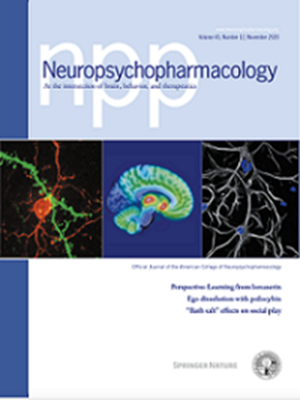大鼠对海洛因的需求:非药物替代品和补品的影响。
IF 6.6
1区 医学
Q1 NEUROSCIENCES
引用次数: 0
摘要
鉴于药物的经济需求在物质使用障碍中的核心作用,确定增加或减少药物价值的因素非常重要。本研究调查了非药物强化物的同时可用性如何影响大鼠对海洛因的需求,这些非药物强化物先前被证明是海洛因的替代品或补体。在实验1中,三组大鼠按下一个杠杆,静脉注射海洛因,价格随着疗程的增加而增加。这些小组在按下第二个杠杆时得到的结果不同:回避暂停强化物、持续低价海洛因或无程序后果。海洛因的基本价值在第二杠杆上有TOA或低价海洛因的组中显着降低。此外,随着第一杠杆海洛因价格的增加,TOA强化剂或低价海洛因注射的消费量增加,证实这些是昂贵海洛因的替代品。在实验2中,两组大鼠按下一个杠杆,注射一系列不断上涨的海洛因。一组可以按下第二个杠杆,以恒定的低价获得糖精强化剂。同时获得糖精会增加雌性大鼠对海洛因的需求,而雄性大鼠则不会。实验3比较了有和没有同时获得低价海洛因的人群对糖精的需求。同时海洛因的可得性导致糖精的无成本估计消费量增加(Q0),但不影响糖精需求的弹性。实验1的结果表明,减轻疼痛或压力的非药物手段可以削弱对阿片类药物的需求。实验2和3表明,相反,一些非药物替代品的可用性可以增加雌性大鼠对海洛因的需求,海洛因可以以低价增加非药物替代品的消费。总的来说,这些结果表明,与情境强化病理学模型一致,阿片类药物的价值取决于更广泛的行为经济背景,在这种背景下,阿片类药物和非药物替代品是可用的。本文章由计算机程序翻译,如有差异,请以英文原文为准。

Demand for heroin in rats: effects of non-drug alternative substitutes and complements
Given the central role of economic demand for drugs in substance use disorder, identifying factors that increase or decrease drug value is of high importance. The present study investigated how the concurrent availability of non-drug reinforcers previously shown to be heroin substitutes or complements affected demand for heroin in rats. In Exp. 1, three groups of rats pressed one lever for intravenous heroin infusions on a series of prices that increased over sessions. The groups differed with respect to what they received for pressing a second lever: timeout-from-avoidance (TOA) reinforcers, heroin at a constant low price, or no programmed consequences. The essential value of heroin was significantly reduced in the groups that had either TOA or low-price heroin available on the second lever. Additionally, as the price of heroin on the first lever increased, consumption of TOA reinforcers or low-price heroin infusions increased, confirming that these were substitutes for expensive heroin. In Exp. 2, two groups of rats pressed one lever for heroin infusions on a series of increasing prices. One group could press a second lever for saccharin reinforcers at a constant low price. Concurrent saccharin availability increased demand for heroin in female rats, but not in male rats. Exp. 3 compared demand for saccharin in groups that had or did not have concurrent access to low-price heroin. Concurrent heroin availability caused an increase in estimated saccharin consumption at no cost (Q0), but did not affect elasticity of demand for saccharin. The outcome of Exp. 1 suggests that non-drug means of reducing pain or stress can weaken demand for opioids. Exp. 2 and 3 show that, in contrast, availability of some non-drug alternatives can increase demand for heroin in female rats and that heroin can increase consumption of non-drug alternatives at low price. Overall, these results show, consistent with the contextualized reinforcer pathology model, that opioid value depends on the broader behavioral economic context in which opioids and non-drug alternatives are available.
求助全文
通过发布文献求助,成功后即可免费获取论文全文。
去求助
来源期刊

Neuropsychopharmacology
医学-精神病学
CiteScore
15.00
自引率
2.60%
发文量
240
审稿时长
2 months
期刊介绍:
Neuropsychopharmacology is a reputable international scientific journal that serves as the official publication of the American College of Neuropsychopharmacology (ACNP). The journal's primary focus is on research that enhances our knowledge of the brain and behavior, with a particular emphasis on the molecular, cellular, physiological, and psychological aspects of substances that affect the central nervous system (CNS). It also aims to identify new molecular targets for the development of future drugs.
The journal prioritizes original research reports, but it also welcomes mini-reviews and perspectives, which are often solicited by the editorial office. These types of articles provide valuable insights and syntheses of current research trends and future directions in the field of neuroscience and pharmacology.
 求助内容:
求助内容: 应助结果提醒方式:
应助结果提醒方式:


